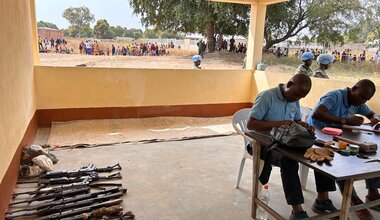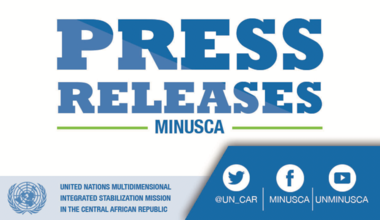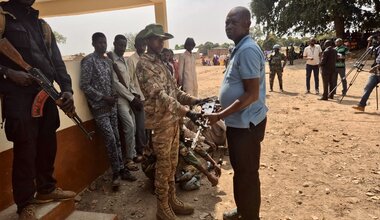A LOCAL PEACE AGREEMENT BRINGS HARMONY TO CAR-SUDAN BORDER COMMUNITIES
Communities on either side of the strategic border town of Am-Dafock on the frontier between the Central African Republic (CAR) and Sudan are reveling in a newfound peace in the locality – despite its proximity to ongoing conflict in Sudan – thanks to a local peace agreement facilitated by the UN peacekeeping mission (MINUSCA).
Located at an important crossroads for trade, culture and historic movements of people between the CAR and Sudan, Am-Dafock in the north-eastern Vakaga Prefecture emerged as a security hotspot over the past few months, in part due to the spillover effects of the ongoing conflict in Sudan. Between June and October 2025, the security situation in Am-Dafock markedly deteriorated.
Worsening security, including increased cross-border incursions and attacks on villages, triggered the mass displacement of more than 2,000 civilians who sought refuge around MINUSCA’s temporary operating base in Am-Dafock, imposed restrictions on movement of people and goods between the two countries, impeded cross-border socioeconomic activities and led to the deterioration of the humanitarian situation. Social cohesion came under threat – with escalating tensions between the Central African and Sudanese communities on either side of the border.

New impetus to local peace initiatives
The quest for peace was high on the agenda when the Special Representative of the UN Secretary-General (SRSG) and Head of MINUSCA, Valentine Rugwabiza, together with the Head of the UN Office for the Coordination for Humanitarian Affairs (OCHA) in the CAR, Abdoulaye Sawadogo, and the MINUSCA Force Commander, conducted a visit to Am-Dafock and the neighbouring town of Birao in early October 2025. During the visit, they met with local authorities, including the Prefect of Vakaga, and local communities. SRSG Rugwabiza encouraged them to engage in intercommunal dialogue to diffuse tensions and seek lasting solutions for peace. She reassured them of MINUSCA's support for local peace initiatives and committed to reinforcing the presence of Mission forces in the area to assure the protection of civilians and facilitate the delivery of humanitarian assistance.

The visit by the Head of MINUSCA gave new impetus to local peace initiatives. Community leaders in cross-border areas subsequently initiated a series of consultations with the technical and logistical support of MINUSCA, which prompted the organization of cross-border dialogue from 27 to 30 October 2025 in Am-Dafock.
Facilitated by MINUSCA, the dialogue enabled representatives of both Central African and Sudanese communities to express their concerns and agree on concrete measures to overcome them. Among other things, the parties committed to respecting transhumance corridors and the integrity of Central African territory, promoting free movement and good neighborliness between the communities, and prohibiting the illegal possession of weapons and military equipment.
Over 100 delegates – religious leaders, women’s groups, community leaders, members of transhumance committees, traders’ representatives – including nine women, took part in the dialogue.
On 30 October 2025, following three days of inclusive intercommunal dialogue, the border communities signed a local peace deal – the Am-Dafock Agreement. The initiative marks an important step in efforts to bring peaceful coexistence and stability to a region long plagued by insecurity and tensions linked to transhumance and the circulation of weapons.
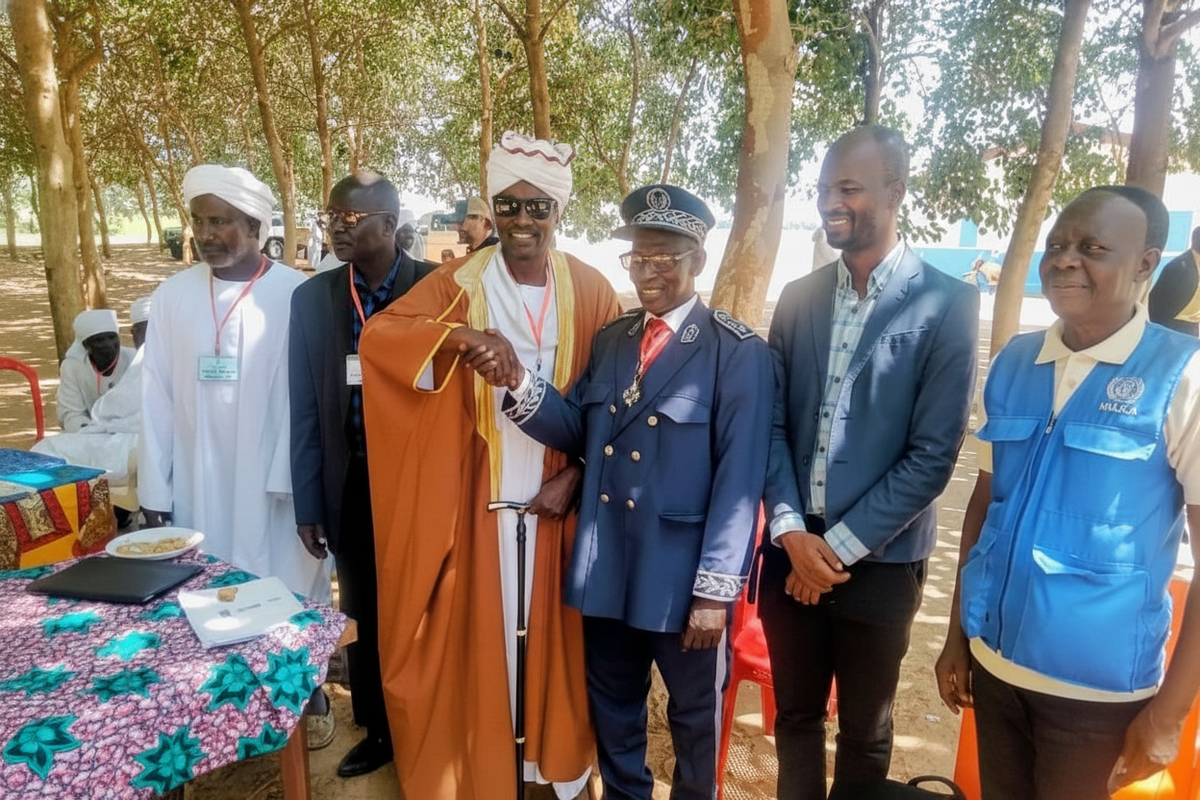
Turning the tide
For the inhabitants of Am-Dafock, the peace agreement brought immediate respite.
“One of the immediate effects of this agreement has been the silencing of weapons. Since its signing, we no longer hear the crackling of weapons in the area, and no security incidents have been reported. Border populations are now able to move freely on both sides,” noted Abdel Kader Ramadan, the Sub-Prefect of Am-Dafock.
The Acting Mayor of the locality, Célestin Tamia, also praised the positive, tangible impact of the accord, already evident following the signing of the peace deal: “The internally displaced persons from the villages of Bashama, Biera and Biri-Biri, who had taken refuge around the MINUSCA base after the incidents in June, have all returned home. They have resumed their farming activities, and the communities have expressed gratitude for MINUSCA’s support.”
Kadij Ousmane, a resident of Am-Dafock, pointed to how the agreement has changed the daily lives of women. “Before, it was difficult to cross the border to go to the market. Now we can go to Am-Dafock, Sudan to buy supplies without any problems,” she said. For her part, fellow resident Adiza Abdalah called for stronger State presence: “We would like to see more gendarmes and police officers to support the implementation of the agreement's recommendations.”
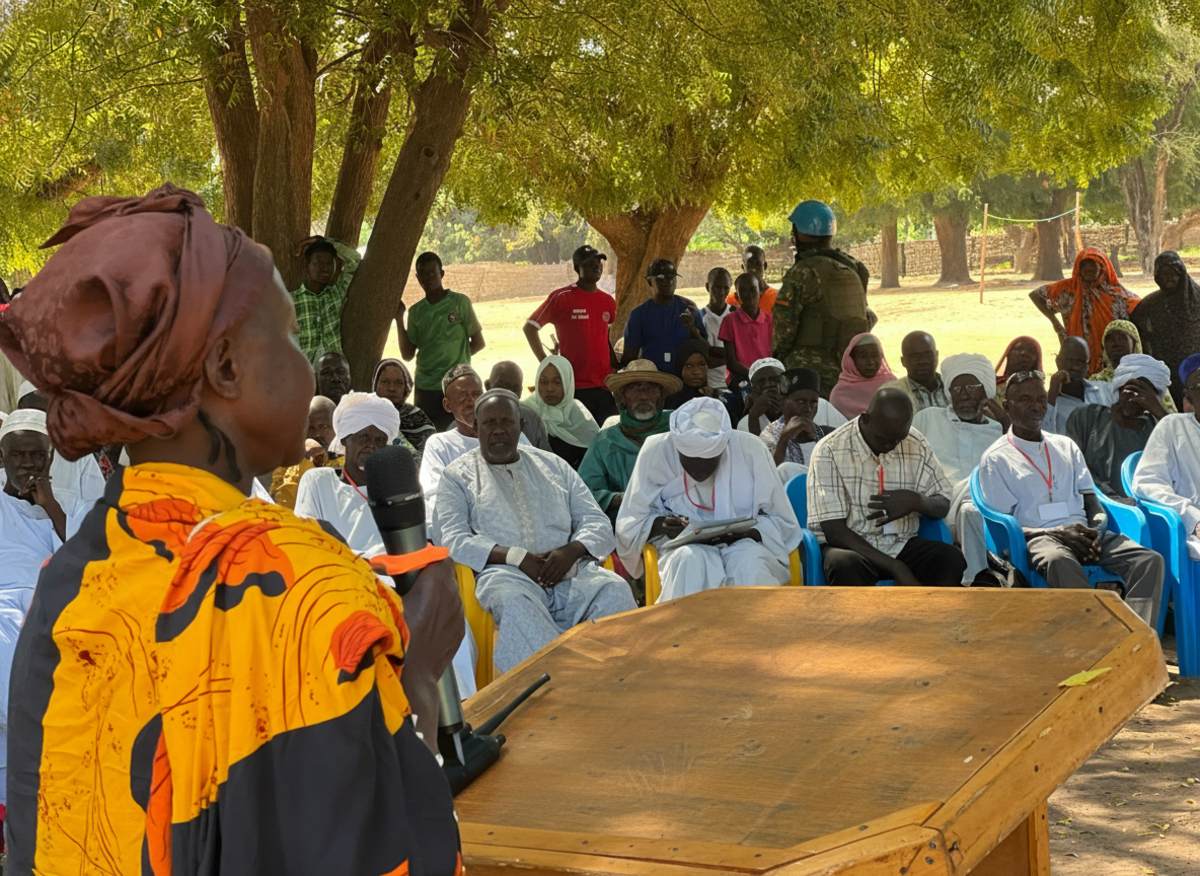
Keeping the momentum
Efforts are ongoing to anchor the agreement among local communities, authorities and civil society – on whose continued active engagement the implementation, dissemination and overall success of the agreement largely depend.
During a joint visit with local authorities and civil society to Am-Dafock in early November, with logistical support from MINUSCA, local authorities took stock of the Mission’s ongoing efforts to protect civilians, consolidate peace, and extend State authority in the area. “The results are visible – of the more than 11,000 internally displaced persons registered in Am-Dafock a few months ago, only about 200 remain today. This proves that security has been restored,” stated Judes Ngayoko, the Prefect of Vakaga. “I would like to thank the Head of MINUSCA for her personal involvement,” he added.
To encourage ownership of the agreement, MINUSCA, in partnership with the United Nations Refugee Agency (UNHCR), local authorities, and the Mission-supported Radio Yata community radio organized interactive public sessions on the content of the agreement.
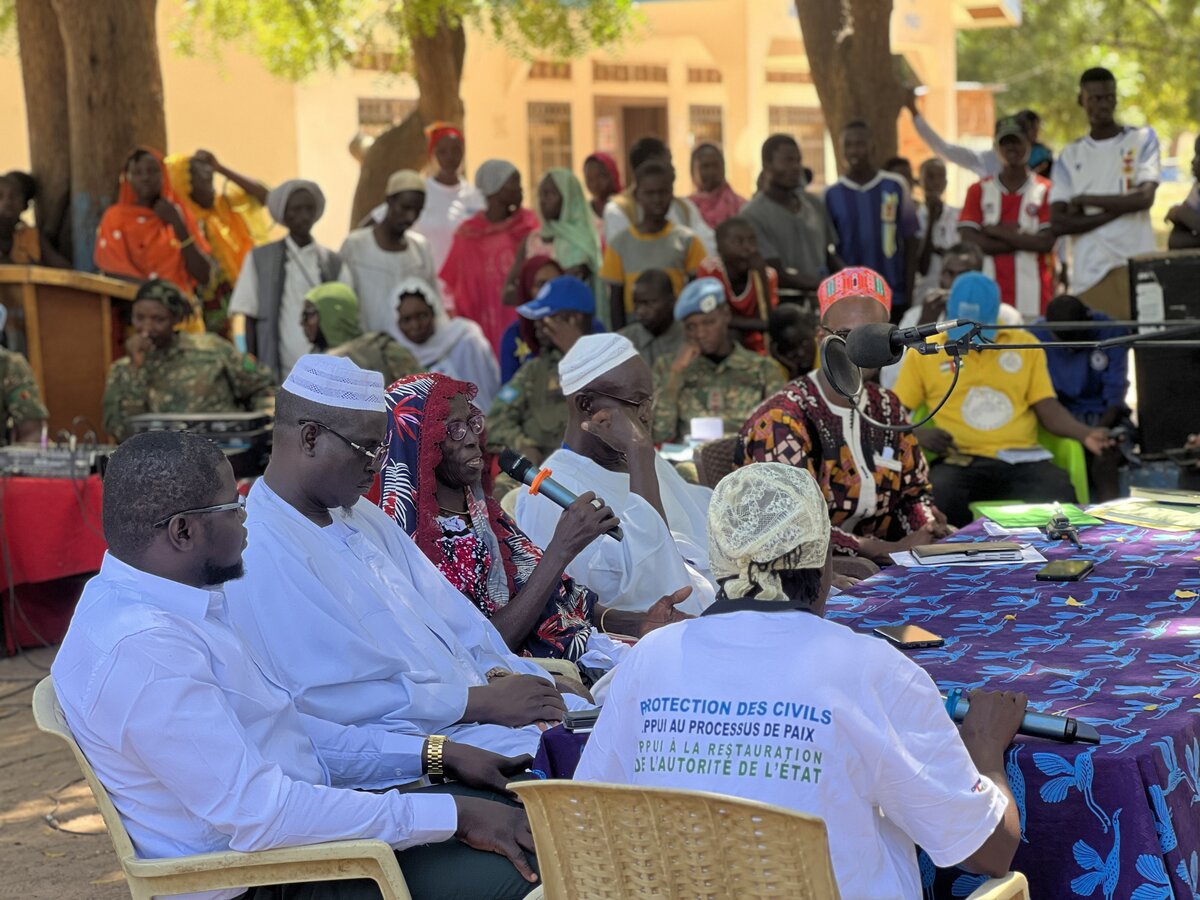
During a recent awareness-raising session at the Birao Town Hall square, Albertine Takia, a representative from the Organisation des femmes centrafricaines (OFCA), underlined how the agreement was a ray of hope for women, who she described as the first victims of conflict: “They suffer sexual violence and are left alone to care for their children when they lose their husbands in conflict.”
Initiatives to spread the word on the agreement are ongoing through community outreach. Through awareness raising, more than 3,000 people, including young people, Sudanese refugees, displaced persons, and community leaders, were informed of the commitments outlined in the agreement and planned actions to ensure its effective implementation.
Way forward
With social cohesion among the key objectives of the peace agreement, and transhumance a common concern between border communities, the local transhumance committee, a central community structure, was tasked with monitoring and reporting on compliance with the agreement.
Mahamat Nour Chaibou, a member of the committee, visited Am-Dafock with MINUSCA’s assistance. “We will continue to seek MINUSCA's support, in consultation with local authorities, particularly the defence and security forces, to ensure compliance with the recommendations made. We have set up a team to visit the sub-prefectures of Ouandja and Ouanda-Djallé, where outreach activities are yet to be organized, to share the recommendations from the agreement with the local population,” he said.
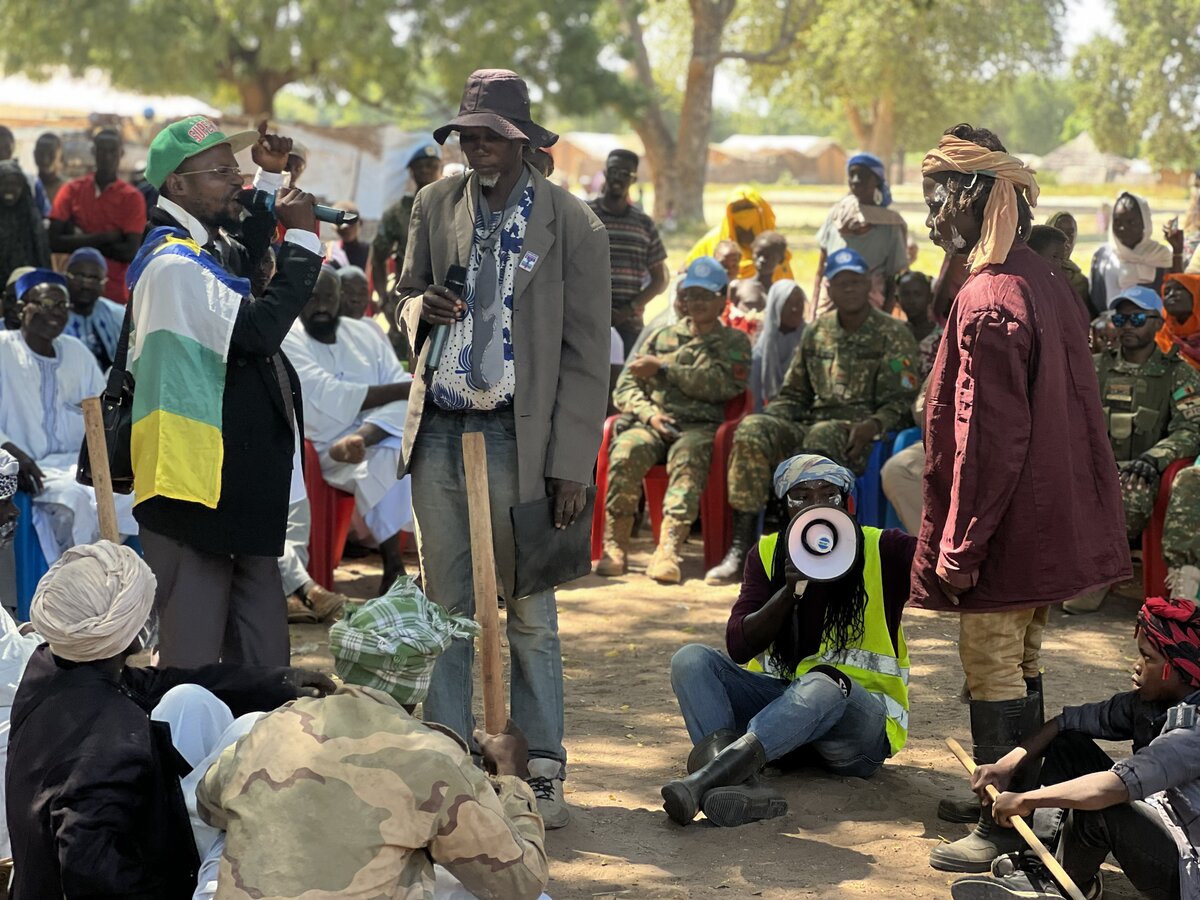
The authorities also recommended holding regular meetings on security to strengthen cooperation between the UN peacekeeping forces on the ground and local communities.
Sustained efforts to protect civilians
MINUSCA has employed diverse measures to strengthen the protection of civilians in Am-Dafock following the outbreak of the conflict in Sudan: the deployment of a temporary operating base in the locality since January 2024; investments of approximately CFA 300 million in Quick Impact Projects (QIPs) and Community Violence Reduction (CVR) programmes, including the construction of the gendarmerie brigade, the town hall, and the Am-Dafock Sub-Prefecture buildings, as well as three drinking water wells. Such infrastructure also contributes to peaceful transhumance and the extension of State authority.

Interventions by the MINUSCA Force coupled with the Mission's engagement with local communities and leaders have contributed to the voluntary return of the majority of displaced populations to their communities in Am-Dafock.
For the Acting Head of the MINUSCA Birao Field Office, Amadou Moctar Diallo, the Am-Dafock Agreement illustrates the importance of community dialogue and strategic partnership between MINUSCA, local authorities, and communities in the search for lasting solutions to conflicts: "The gradual return of security, the restoration of freedom of movement, and the massive return of internally displaced persons are encouraging indicators that we must continue to consolidate. Am-Dafock remains a priority for MINUSCA, as illustrated by the Special Representative's high-level visit and MINUSCA's multifaceted actions in the area.”
 UN
UN United Nations Peacekeeping
United Nations Peacekeeping



